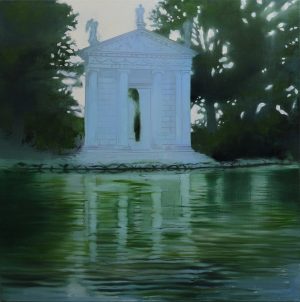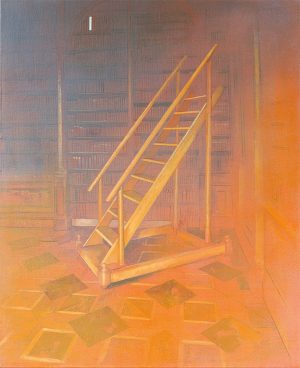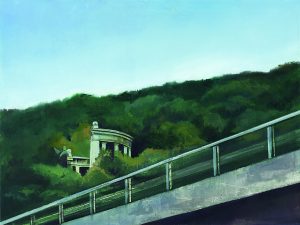
Attila KONDOR
The Paths of Attention
- Year(s)
- 2021
- Technique
- oil on canvas
- Size
- 50x70 cm
Artist's introduction
Attila Kondor represents a figurative derivation of oil painting that emerged after the turn of the millennium, drawing on the Italian tradition and striking a metaphysical note. He also created animations based on his meditative paintings, which use elements of classical architecture and garden design. "The images of the contemplative, conceptual animations are created on canvas and prints, where the presence of stillness and silence is conveyed not only by harmonious proportions and tonal transitions of soothing colours but also by the apparition-like glow of the highlights that almost split the painting plane, suggesting a supernatural light" - wrote art historian János Schneller about the artist's meditative approach. Kondor, born in Budapest, graduated from the Hungarian University of Fine Arts in 2000 with a degree in Graphic Arts. At that time, his artistic perspective was characterised by the traditional oil painting method and a search for classical themes. During his time at the university, he turned against the conceptual practice that dominated the intellectual climate of the 1990s and, as a rebellious gesture, painted plein air landscapes of the Élesd countryside in Transylvania as a member of the Sensaria Group, a group of traditionalist painting students. Although the group's attitude towards classical painting resonated among the realist tendencies that were gaining ground in the early 2000s, Kondor was isolated from the group because of his essentially philosophical, contemplative character. He was strongly influenced by Italy, the home of classical architecture and traditional garden design. His early paintings depicted unpopulated, meditative Italian castle gardens with reflecting surfaces of water, silent colonnades and classical sculptures. Subsequently, his canvases depicted architectural fragments from Budapest. Smudges and tactile surfaces accompanied his pictorial character's realistic, austere perspective. By the end of the decade, he found his own distinctive, individual iconography: gateways, staircases, marble halls and libraries, lifted from classical architecture and given symbolic power. Kondor's historical and philosophical worldview suggests that the proportions of the gates, windows and spaces correspond to the "majesty of the cosmos". The pictorial voids, highlighted by graphic white stripes or negative forms, indicate the proximity of mystery in this Arcadian, introspective world. Since 2013, Kondor has also been making meditative animated films from the "raw material" of his paintings, besides the oil paintings that he is constantly creating. He lives and works in Budapest. Gábor Rieder
More artworks in the artist's collection »





















